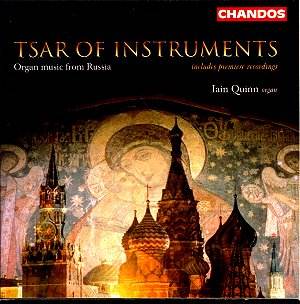The organ school of Russia is among the less known.
The main reason for this is that the Russian Orthodox Church had no
place for the organ, and thus not many compositions were composed for
the instrument. Concerts were rare on the few existing secular instruments.
The period since the 1950s brought a wave of new organ building in large
towns. A marked increase in the quantity of organ concerts encouraged
Russian composers to write for the instrument.
The first organ in Russia dated back to the 11th
century and is associated with the Cathedral of St Sofia in Kiev. Another
major construction dated back to 1672, when a fine organ by Gutowski
equipped the Court Theatre. During the reign of Peter the Great (1682-1725),
the interest in western European music was strong. By that time the
Hamburg organ builder Arp Schnitger built organs in Russia. By the end
of the 18th century concerts with symphonic and secular music
were held in churches and the works of Bach became known and influenced
Russian composers. Prince Vladimir Odoyevsky wrote the first original
organ works in the late 1840s. He was a friend of Glinka who often improvised
in Odoyevsky’s organ for the high society of Moscow and St Petersburg.
Liszt was highly impressed by Glinka’s talent in improvisation and he
also held a recital in Moscow in 1843. The activity of organ builders
continued during the 19th century. German organ builders
such as Walcker, Sauer, Ladegast and Steinmeyer & Co made most of
the organs. The establishment of organ departments within the Moscow
and St Petersburg conservatoires gave a flourishing cultural effect.
Tchaikovsky was among the first organ students at the St Petersburg
Conservatory. E. F. Walcker built the organ there in 1897, whereas the
one in the Moscow Conservatory was built by A. Cavaillé-Coll
in 1899. Famous organists such as Widor, Tournemire and Bossi were heard
in Russia by that time. Since then many organs were built in concert
halls and other places by Rieger, Sauer, Schuke and Eule.
This CD, as the small booklet inform us, brings ‘together
occasional organ works by Russia’s more important composers’.
Reinhold Glière, a pupil of Taneyev amongst
others, wrote orchestral music in which expressive melody is the strongest
element. The Fugue on a Russian Christmas Song is ‘an imaginative three-voice
fugal treatment of a beautiful traditional melody’. Mikhail Glinka is
the father of the classical Russian music. His organ fugues show his
‘command of the medium’. Alexander Grechaninov studied with Rimsky-Korsakov.
The fine Adagio is a beautiful piece in three parts and this is its
premiere recording. Another premiere recording is that of Sergey Rachmaninov’s
Andante, a piece emotionally fuelled by Tchaikovsky’s death. It is Rachmaninov’s
only contribution to the solo organ literature. Taneyev was the antithesis
of Glinka. He mastered the compositional techniques but lacked imagination
and expressiveness. He studied the great contrapuntalists of the past
and the result is a body of precise and polished compositions. The Choral
Varié is ‘one of the best organ works by any Russian composer’.
The third premiere recording of this CD is Dmitri Shostakovich’s only
extended solo organ works, the Credo and the Cathedral Service. They
are ‘self-explanatory in mood and characterization’. Glazunov has a
significant place in Russian music as he succeeded in joining together
Russianism and Europeanism. He was the direct heir of Balakirev’s nationalism
but tended more towards Borodin’s epic grandeur. His organ pieces performed
here are very fine pieces, well balanced and with nice effects.
The Willis/Harrison& Harrison organ of Winchester
Cathedral provides all the necessary sounds for this music and the selected
registrations work very well.
Quinn’s playing though comes across as not totally
committed. His interpretations are for the most part not convincing.
This is due to the absence of rhythmic vitality and therefore continuity.
There is also a tendency to run things forward, rather than sit back
and enjoy the harmonies that fill the big acoustics of the cathedral.
The performances, though sensitive (especially the Fantasy by Glazunov),
are breathless without points of repose. The lack of breathing causes
also unnecessarily sharp accents at the end of phrases. There is occasionally
something that sounds like rhythmical misreading, as in Glazunov’s Prelude
and Fugue in D maj, Op. 93, bar 192 of the fugue and at Glinka’s Fugue
in E flat major at the Coda Largo section.
This CD nevertheless deserves a welcome, as it brings
a not at all well-known genre of music to a wide audience.
Christina Antoniadou

